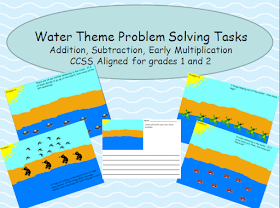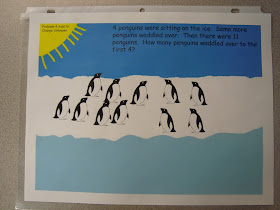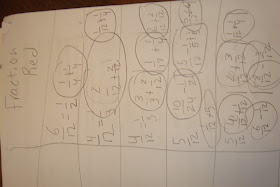My first and second graders (and sometimes third) often struggle with this concept. Here is a peek at the Common Core Standards that specifically address compare problems
First Grade
CCSS.Math.Content.1.OA.A.1 Use addition and subtraction within 20 to solve word problems involving situations of adding to, taking from, putting together, taking apart, and comparing, with unknowns in all positions, e.g., by using objects, drawings, and equations with a symbol for the unknown number to represent the problem.1
Second Grade
CCSS.Math.Content.2.OA.A.1 Use addition and subtraction within 100 to solve one- and two-step word problems involving situations of adding to, taking from, putting together, taking apart, and comparing, with unknowns in all positions, e.g., by using drawings and equations with a symbol for the unknown number to represent the problem.1
CCSS.Math.Content.2.MD.A.4 Measure to determine how much longer one object is than another, expressing the length difference in terms of a standard length unit.
CCSS.Math.Content.2.MD.B.5 Use addition and subtraction within 100 to solve word problems involving lengths that are given in the same units, e.g., by using drawings (such as drawings of rulers) and equations with a symbol for the unknown number to represent the problem.
CCSS.Math.Content.2.MD.D.10 Draw a picture graph and a bar graph (with single-unit scale) to represent a data set with up to four categories. Solve simple put-together, take-apart, and compare problems1 using information presented in a bar graph.
CCSS.Math.Content.3.OA.D.8 Solve two-step word problems using the four operations. Represent these problems using equations with a letter standing for the unknown quantity. Assess the reasonableness of answers using mental computation and estimation strategies including rounding.
CCSS.Math.Content.3.MD.B.3 Draw a scaled picture graph and a scaled bar graph to represent a data set with several categories. Solve one- and two-step “how many more” and “how many less” problems using information presented in scaled bar graphs. For example, draw a bar graph in which each square in the bar graph might represent 5 pets.
Here is a fun and easy way that I help my students with comparing lengths. It has great tie-ins to science and we can go off on huge tangents about force, friction etc but in this post, I am going to focus on the math related questions I ask during this lesson.
It is a VERY engaging lesson, so I usually save it for those hard to plan for, full of wiggle days like the day before a vacation or holiday or the days leading up to summer vacation. I have done this lesson or a similar one with a few tweaks in first grade up through sixth grade. I will be showing you pictures of a second grade lesson and at the end will give you some ideas about how I adapt it for older and younger kids.
The set up:
I use unifix cubes snapped into groups of 10 and alternate colors going down the track. I use a binder as a ramp. In the picture you see a 1 inch binder but I have used smaller and larger binders depending on how far I want the balls to roll (I also use matchbox cars in some cases). I often use a long sheet of paper that is about 12 inches wide underneath so that there is less friction and the balls go farther. I line both sides of the track with unifix cubes to ensure the balls stay on course.
The set up:
I use unifix cubes snapped into groups of 10 and alternate colors going down the track. I use a binder as a ramp. In the picture you see a 1 inch binder but I have used smaller and larger binders depending on how far I want the balls to roll (I also use matchbox cars in some cases). I often use a long sheet of paper that is about 12 inches wide underneath so that there is less friction and the balls go farther. I line both sides of the track with unifix cubes to ensure the balls stay on course.
I set the track up ahead of time or have a kid help me set it up. Having a kid help who needs some more work with groups of ten is a great way to kill two birds with one stone. I also write the name of the ball on a sticky note ahead of time so we are ready to record their distances.
The first two balls we rolled were the steel ball and the large marble. We stop and ask how much farther did the marble go than the steel ball? Kids give me a ready signal when they are ready. They then turn and talk with a partner about what their answer is and how they know they are right. This lets me hear a lot of answers all at once and gives me a good idea about who should share with the whole group. I often ask a kid to explain their partner's answer to me. This gives them practice looking at a problem a different way and ensures that they are actually listening when their partner is talking.
When all the balls have been rolled, I finish up with some compare questions. I also often ask questions like how much farther would the ping pong ball have to have gone to get to 100? This is similar to asking how much farther did one go than the other but can sound very different to kids.
HERE IS THE VERY IMPORTANT PART!!!!!
We just spent half and hour working as a whole group doing some really fun and exciting math that gets at the big idea of compare problems. I want this fun and excitement to continue so I preserve our game board by having a few students help me turn it into a number line. Check it out!
The next day, I met with 6 kids that I noticed were struggling a bit with the whole group lesson. We sat right in front of our number line record and talked about what happened and how much farther some balls went than others. They got more practice doing compare problems using a visual model (the number line) to help them.
The day after that, I created a written practice sheet that had compare questions on it about how far various balls went and used it as a station in our math rotation for that day. I was doing some end of the year assessments and had several workstations set up around the room. This one was a big hit and kids kept the excitement they had about doing this activity and were happy to be digging back into it. Their very favorite part was writing their own questions for their partner to answer about what happened.
When I want to work on fractions with this idea, I often snap either 8 or 12 cubes together to make 1 unit. This gets kids into thinking in eighths or twelfths and their related fractions. It also gets kids thinking about fraction addition and subtraction in a fun and supported way. Next time I do this with fractions or decimals, I will take a lot of pictures and write a post about it. It is a great experience to give your students!
How do you help your students with compare problems?
The first two balls we rolled were the steel ball and the large marble. We stop and ask how much farther did the marble go than the steel ball? Kids give me a ready signal when they are ready. They then turn and talk with a partner about what their answer is and how they know they are right. This lets me hear a lot of answers all at once and gives me a good idea about who should share with the whole group. I often ask a kid to explain their partner's answer to me. This gives them practice looking at a problem a different way and ensures that they are actually listening when their partner is talking.
 |
| One section of our track got REALLY crowded this time! |
HERE IS THE VERY IMPORTANT PART!!!!!
We just spent half and hour working as a whole group doing some really fun and exciting math that gets at the big idea of compare problems. I want this fun and excitement to continue so I preserve our game board by having a few students help me turn it into a number line. Check it out!
The next day, I met with 6 kids that I noticed were struggling a bit with the whole group lesson. We sat right in front of our number line record and talked about what happened and how much farther some balls went than others. They got more practice doing compare problems using a visual model (the number line) to help them.
The day after that, I created a written practice sheet that had compare questions on it about how far various balls went and used it as a station in our math rotation for that day. I was doing some end of the year assessments and had several workstations set up around the room. This one was a big hit and kids kept the excitement they had about doing this activity and were happy to be digging back into it. Their very favorite part was writing their own questions for their partner to answer about what happened.
Using this activity with K/1 kids
Since I had all of this stuff out, I also used it in K and 1 this week. With these younger students, I did do some compare problems but the students relied heavily on the cubes to help them figure out the answer. My focus shifted a great deal to multiple ways to figure out how far the balls went. Some kids in this age range always go back to zero and count forward. Others are able to use a previously placed sticky note and count on from there. Having these discussions with kids was very valuable! Also we focused on writing numbers up to 120 and what each part of the number means. Example: When a student wrote 82, I could ask them what the 8 in the number meant and how they could see the 8 in the cubes. This led directly to the seeing that there were 8 groups of ten or eighty. I also wanted the marbles to go a bit farther so I had the "start point" be at the top of the binder. This ensured a lot of the balls were falling in the 100-120 range which is where these kids need the most practice at this stage.Using this activity with older kids
By changing the value of the cubes, you can easily extend this game into fractions and/or decimals. I have used it for decimals by making each group of 10 cubes worth 1 unit. Then each cube is a tenth and you get a lot of great connecitons that way. The compare problems become a matter of adding up or subtracting decimals. GREAT PRACTICE! Very visual and supported by the materialsWhen I want to work on fractions with this idea, I often snap either 8 or 12 cubes together to make 1 unit. This gets kids into thinking in eighths or twelfths and their related fractions. It also gets kids thinking about fraction addition and subtraction in a fun and supported way. Next time I do this with fractions or decimals, I will take a lot of pictures and write a post about it. It is a great experience to give your students!
How do you help your students with compare problems?



















































